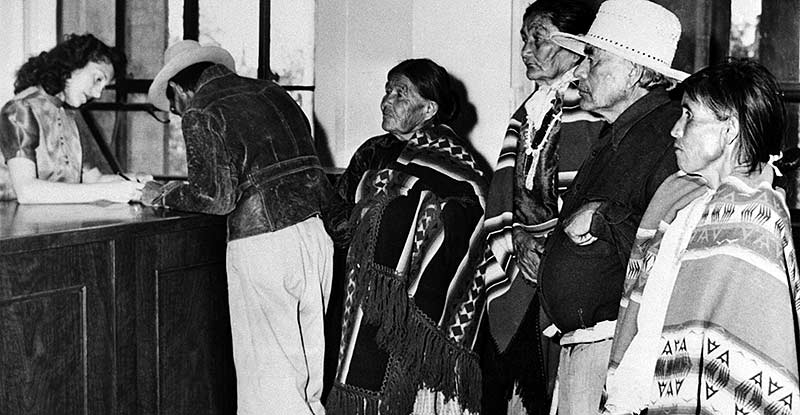
50 Years Ago: LBJ's laws to increase Black voting also helped Navajo voting rights

In 1948, after years of legal challenges, Native Americans in New Mexico gather to register to vote. (Courtesy of history.com)
Anyone who was over the age of 15 in 1965 and who watched television news or read the newspaper knew that one of the major stories of that year was U.S. President Lyndon Baines Johnson and his attempt to make it easier for Blacks in the South to vote.
The Voting Rights Act that was being pushed by Johnson that year was meant to increase Black voting in the South despite the fact that many Southern states and counties would continue to fight to suppress that voting.
But what a lot of Navajos probably didn’t know until they read about it in the Navajo Times was that these same laws would affect them as well because like counties in the South, counties within the Navajo Reservation borders had been doing the same thing for decades – trying to keep Navajos from voting in county elections.

In 1948, after years of legal challenges, Native Americans in New Mexico gather to register to vote. (Courtesy of history.com)
One of the ways was pretty simple – in order to vote in any county or state election in 1965, the voter must prove that they could read the U.S. Constitution and understand what it meant. This one provision would eliminate 85 percent of all Navajo adults from voting.
It wasn’t exactly a race thing, said the Times, although there were probably a lot of people in the southern part of Apache, Navajo and Coconino counties, who were prejudiced against Navajos because of their race.
No, the big problem with the non-Native population was a feeling that anyone who didn’t pay taxes had no right to vote on matters that affected taxpayers.
This would be a problem that would continue to draw attention for another 15 years but in 1965 both Navajos and non-Navajo, according to the Times, were adjusting to the new era of civil rights.
Throughout April, the Times would tackle this problem in front-page articles, some of which were reprinted from the Arizona Republic.
One of these articles, written by the Republic’s Bill Nixon, pointed out that getting Navajos out to vote, as opposed to the Blacks in the South, was quite different because the Blacks wanted to vote and the Navajos basically didn’t.
A lot of Navajos still had no idea what their county governments could do to make their life better.
“Education appears to be the final answer,” Nixon said, “but this will take many years.”
The attorney general for the United States, Nicholas Katzenbach, would talk about the Navajos voting right when he spoke to a House subcommittee that year.
He said that if the voting law was approved, federal voting officials would be assigned to monitor the voting on the reservation in non-tribal elections for many years.
Nixon, in his article, pointed out that the size of Apache County is enormous.
“The Chinle, Lukachukai and Ganado voting districts are each larger than the state of Rhode Island,” the Nixon article stated.
He also talked about illiteracy on the reservation.
“The inability of so many Navajos to read and write leaves them ignorant,” Nixon said, “of anything political outside of their own tribal elections.
“At that, tribal ballots use a visual aid – photos of the candidates to help the illiterate cast ballots,” he added.
In other news, there was some confusion among readers of the Navajo Times since April’s issues continued to have the Marshall Tome Smoke Puffs column despite the fact that he had resigned as editor of the paper.
This was good news for the paper since Tome’s column was very popular among the readership of the paper because it provided a different perspective on the news.
If you asked most readers of the Times why they were willing to pluck down 10 cents every week to pick up the newspaper, you would probably find a lot who actually read the paper for its coverage of Navajo news.
But there were also a lot of readers who seemed to be attracted to only one page – the editorial page where Tome’s column appeared each week.
It wasn’t usually controversial but readers loved his articles on the editorial page each week just talking about some of the things he heard about during the week that caught his fancy.
When he agreed to continue writing the column, he guaranteed that he would have nothing to do with the rest of the paper, saying he was tired of being caught between the various factions within the tribal government.
And from week to week, he had no idea how long he would be able to stay at the paper before he got so fed up again that he would resign or because the paper would get so controversial that he would be fired.
There were other things he wanted to do but given the political infighting that was going on within the tribe between the council and the chairman, Tome knew it would be hard to find another job that was so fulfilling both spiritually and financially.
Later, in talking about these years, he would say that he always had a hope that the two sides would just sit down and reach a compromise on how the tribal government should be run instead of spending a lot of their time fighting with each other over almost every issue before the government.
To read the full article, pick up your copy of the Navajo Times at your nearest newsstand Thursday mornings!
Are you a digital subscriber? Read the most recent three weeks of stories by logging in to your online account.







 Highway 264,
Highway 264, I-40, WB @ Winslow
I-40, WB @ Winslow